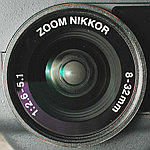
The on-camera zoom lens covers focal length 8mm to 32mm as marked on the lens:

The 35mm equivalent of 8mm-32mm is 38mm-152mm, which covers not-so-wide-angle to moderate telephoto. This is a variable aperture zoom lens, which means the maximum aperture changes as the lens is zooming. The lens marking shows that the wide side (i.e., 8mm) has maximum aperture F2.6, and the tele side (i.e., 32mm) has maximum aperture F5.1. The effect of zooming-in or -out can be viewed on both the viewfinder and LCD monitor. But, using the LCD monitor is preferable if the subjects are very close to the camera because of the parallax problem. See Autofocus Overview for the details. This lens also has very good quality for macro photography, and can focus down to about 2cm. See Close-Up for the details. In what follows, we shall provide a very general overview of a number of concepts and the meaning of some terms.
When you change focal length, you will notice two important effects: angle of view and magnification. When the focal length becomes smaller (resp., larger), the coverage of the scene is wider (resp., narrower). It would be very helpful if you know the correspondence between the 35mm focal length and the focal length of 995's on-camera lens. The following gives an approximation of this conversion:

For example, 12mm on a 995 is equivalent to 57mm on a 35mm camera. On the other hand, 105mm on a 35mm camera is equivalent to 22.1mm on a 995. The following images show the coverage of commonly used focal lengths. They are 38mm, 50mm, 85mm, 100mm and 150mm (35mm equivalent). The corresponding 995 focal lengths of 38mm, 50mm, 85mm, 100mm and 150mm are, approximately, 8mm, 10.5mm, 17.9mm, 21.1mm and 31.6, respectively.

|
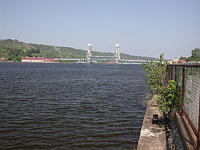
|
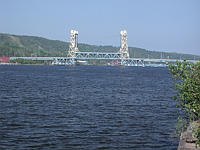
|
| 38mm | 50mm | 85mm |
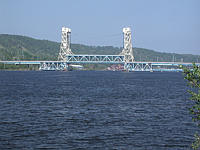
|
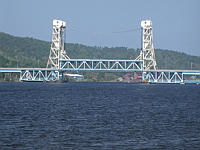
|
| 100mm | 150mm |
| Click on the image to see a larger one | |
Focal length 50mm is the standard or normal focal length, because a 50mm lens (for 35mm cameras) covers approximately what human eyes can see. A smaller focal length than 50mm is called wide angle since its coverage is wider than that of a normal lens. See the images of 38mm and 50mm above. Focal lengths larger than 50mm are telephotos, because they can bring distant subjects closer like a telescope does. The on-camera lens provides the so-called moderate telephoto, because its maximum focal length is 152mm.
The on-camera lens provides the most commonly used focal range (i.e., 38mm - 152mm). The wide end is usually used for scenic shots and the tele end is good for portraiture. If the desired focal length is not in this range (i.e., wider than 38mm to cover a wider area or longer than 152mm to bring distant subjects closer), you have to use lens converters. Nikon manufactures a fisheye converter (FC-E8), two wide angle converters that can bring the focal length down to 24mm (WC-E24 and WC-E63), a 2X tele converter that extends the focal length to 304mm (TC-E2), and a 3X tele converter that extends the focal length to 456mm (TC-E3ED). Click here for an overview of these lens converters.
You might also consider to add a protection filter on the lens. The filter thread size is 28mm. The two most commonly used filters are UV filter and Polarizing filter (or polarizer for short). Click here for an overview of using filters.
When you point the lens to the sun or a very strong light source, lens flare and/or ghost may occur in your image. The left image below shows such an effect. The area near the bright spot (i.e., the sun) is washed out. In fact, flare occurs even though the strong light source is not in the image. Flare occurs due to light bouncing off the glass surfaces of the lens (i.e., internal reflection) rather than transmitting through. Because of this internal reflection, image contrast and tonality are reduced.
|
|
|
| Lens flare and ghost | |
| Click on the picture to see a full size one | |
The right image above illustrates another effect, ghost, a string of color dots appearing in the image. The washed-out effect (i.e., flare) is still there near the upper-left corner, but is not as strong as the one shown in the left image above. However, there is a string of dots, usually in green, purple or violet, appears in the image. These dots have the shape of the aperture of the lens and are not part of the actual scene. Therefore, they are called ghosts! Most low cost zoom and wide angle lenses, suffer this problem. The image below shows flare, ghost and severe washed-out. Sun light comes in from the upper-left corner, and, as a result, you can see the shape of the aperture there. The bottom washed-out part is caused by water reflection. With a better lens, surfaces of glasses are multicoated with special anti-reflection chemicals to prevent flare and ghost. However, even though with a multicoated lens like the on-camera one, flare and ghost cannot be eliminated completely. See Coated or Non-Coated for more details about lens coating.
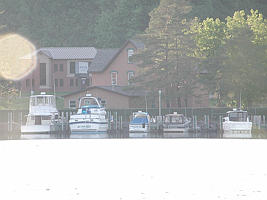
|
| Lens flare, ghost and severe washed-out |
| Click on the picture to see a full size one |
To overcome this problem, please do not point the lens directly toward or near a strong light source. If this cannot be avoided because it is your favorite scene, try to hold a piece of paper or use your hand or a lens hood to block the incoming light. It usually partially solves this problem.
Also note that the right image above has vignetting (i.e., shadows in the corners). This is because a polarizer is stacked on a UV filter and then zoomed out. To avoid this vignetting problem, do not stack filters on top of each other.
There are two types of obvious field curvature: barrel and pincushion. Both types are slightly visible with on-camera zoom lens. Barrel distortion means straight lines in real world bow outward in images. The closer to the image edges, the worse the barrel distortion. Barrel distortion usually occurs in the wide angle side. On the other hand, pincushion distortion means straight lines in real world bow inward in images. Similar to barrel distortion, the closer to the image edge, the worse the pincushion distortion. Pincushion distortion usually occurs in the tele side.
|
|
|
| Barrel distortion | Pincushion distortion |
| Click on the picture to see a larger one | |
The left image above shows an example of barrel distortion. The edge of the building and the pole bow outward. The right image above shows an example of pincushion distortion. A yellow line connecting the two endpoints of the roof is drawn. Comparing this line and the edge of the roof, you should see pincushion distortion.
Since the refractive index of all transparent materials varies with wavelength. It means a lens, in general, is not able to focus all three primary colors (i.e., red, green and blue) at the same point without applying some kind of optical correction. A lens in which two primary colors are corrected and united so that they focus at a common image point is said to be achromatic, while if all three primary colors are corrected and united is said to be apochromatic. A lens in which none of the primary colors are brought to the same image point suffers chromatic aberration. Therefore, the image produced by such a lens frequently contains color fringes that are not part of the actual scene. In digital cameras, the image capturing devices (e.g., CCDs) also contribute come degree of aberration. Because the sensors of an image capturing device are densely packed, it is possible that the color captured by one sensor may ``propagate'' to its neighbors, and, an effect that is similar to chromatic aberration occurs.
The areas marked by yellow rectangles in the following image show the impact of chromatic aberration.
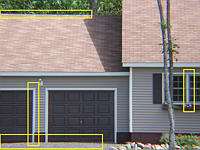
|
| Click on the image to see a larger one |
The lower-left corner and far right edge of the above image are cropped and shown in the following images. Click on the image to see the portions in original resolution. In the left image below, there is a vertical purple fringe between the frame and garage door, and a horizontal orange fringe between the garage door and ground. In the right image blow, purple fringe also occurs along the window frame. These color fringes are the results of chromatic aberration and can reduce the quality of images. In general, boundaries between two high contrast areas are the places where color fringes may occur.
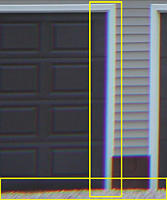
|

|
| Click on the image to see a larger one | |
Nikon Coolpix 995 supports two types of zooms, Optical Zoom and Digital Zoom. The latter provides a way to blow up the center part of a captured image using software algorithms, thereby offering a digital equivalent of telephoto lens with lower image quality. Also refer to Lens Converter Overview for more information.
![]()
The following lens technical information are taken from Nikon's manual.
| Item | Technical Data |
| Number of lenses | 10 elements in 8 groups |
| Zoom Ratio | x4 |
| Focal length | 8mm - 24mm or 38mm - 152mm (35mm equivalent) |
| Maximum Aperture | F2.6 (wide) to F5.1 (tele) |
| Coating | Nikon Super Integrated Coating |
| Minimum range | 30cm/11.8 in to infinity |
| Minimum range, macro | 2cm/0.84 in to infinity, Manual focus |